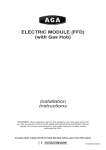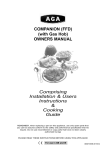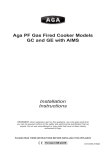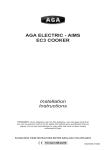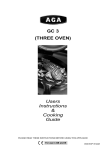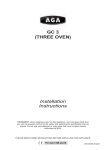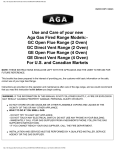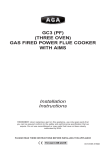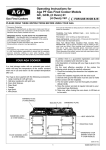Download AGA ELECTRIC HOB UNIT Specifications
Transcript
2 BURNER GAS HOB OPTION (FFD) (For use in 4 Oven Aga Cookers Only) Installation Instructions LEAVE WITH CUSTOMER THIS PRODUCT IS NOT RETROFITABLE PLEASE READ THESE INSTRUCTIONS BEFORE INSTALLING THIS APPLIANCE For use in GB and IE 04/07 EINS 512048 CONTENTS SECTION PAGE GENERAL REQUIREMENTS 3 SPECIFICATIONS 4 TECHNICAL DATA 5 INSTALLATION SEQUENCE & PROCEDURE 6-14 2 GENERAL REQUIREMENTS IMPORTANT PLEASE READ THROUGH COMPLETELY BEFORE COMMENCING INSTALLATION. WARNING: THIS APPLIANCE SHALL BE INSTALLED IN ACCORDANCE WITH THE REGULATIONS IN FORCE AND ONLY USED IN A WELL VENTILATED SPACE, READ THE INSTRUCTIONS BEFORE INSTALLING OR USING THIS APPLIANCE. PRIOR TO INSTALLATION, ENSURE THAT THE LOCAL DISTRIBUTION CONDITIONS (TYPE OF GAS AND GAS PRESSURE) AND THE ADJUSTMENTS OF THE APPLIANCE ARE COMPATIBLE. THE ADJUSTMENT CONDITIONS FOR THIS APPLIANCE ARE STATED ON THE DATA PLATE , WHICH IS SITUATED INSIDE THE HOB UNIT ON THE METAL BASE. This appliance is not connected to a combustion products evacuation device. It must be installed and connected in accordance with current installation regulations. Particular attention shall be given to the relevant requirements regarding ventilation (B.S. 5440 Part 2). It should be in accordance also with any relevant requirements of the gas Region and Local Authority. In your own interests, and that of safety and compliance with the law, all gas appliances must be installed by a competent person. Failure to install the appliances correctly could lead to prosecution. On completion, test the gas installation for tightness. WARNING: THIS APPLIANCE MUST BE EARTHED. The appliance is designed for the voltage stated on the data plate. Any adjacent walls that project above the height of the hob must be of heat resistant material. Surfaces over the top of the hob must not be closer than 650mm. THE ISOLATOR SHOULD NOT BE POSITIONED IMMEDIATELY ABOVE THE HOB OR THE MAIN COOKER, BUT MUST BE SITED WITHIN 1.5 METRES OF THE APPLIANCE. The hob must be wired and installed by a Qualified Engineer in accordance with the Current National Wiring Regulations and also any local regulations which may apply. The appliance requires a 3 amp, 230 volt ~ 50 Hz supply. The method of connection to the mains supply should ensure complete electrical isolation of the appliance by the use of a fused double pole switch having a contact separator of at least 3mm serving only the appliance. The point of connection should be accessible and adjacent to the appliance. The installation should be protected by a 30 mA Residual Current Circuit Breaker (RCCB). IMPORTANT The wires in the mains lead on this appliance are coloured in accordance with the following: Green/Yellow - Earth Blue - Neutral Brown - Live 3 SPECIFICATIONS REAR GAS INLET HOLE POSITION (HOB UNIT) SIDE ELECTRICAL CONNECTION HOLE (HOB UNIT) 1487 60 1340 1330 67 830 632 210 851 41 370 3 REAR ENTRY ELECTRICAL CONNECTION 39 51 679 210 756 67 698 1125 591 41 SIDE ENTRY ELECTRICAL CONNECTION 39 116 Fig. 2 DESN 512066 A COOKER DIMENSIONS When surveying for a cooker installation the actual clearance required for the ‘body’ of the appliance should be increased overall by 10mm beyond the figures quoted. This allows safe margin to take into account the natural dimensional variations found in major castings. In particular the width across an appliance recess could be critical. 4 51 TECHNICAL DATA NATURAL GAS - G20 (APPLIANCE CATEGORY 12H) FRONT BURNER REAR BURNER BURNER TYPE SEMI-RAPID RAPID MAXIMUM HEAT INPUT 1.75kW 3.25kW INJECTOR MARKING 097 130 PRESSURE POINT POSITION: INJECTOR OF REAR BURNER PRESSURE SETTING: 20mbar BURNER IGNITION: H.T. SPARK PROPANE G31 - (APPLIANCE CATEGORY 13P) FRONT BURNER REAR BURNER BURNER TYPE SEMI-RAPID RAPID MAXIMUM HEAT INPUT 1.75kW (125g/h) 3.0kW (214g/h) INJECTOR MARKING 65 90 PRESSURE POINT POSITION: INJECTOR OF REAR BURNER PRESSURE SETTING: 37mbar BURNER IGNITION: H.T. SPARK 5 INSTALLATION SEQUENCE AND PROCEDURE Loose Items On unpacking the hob unit, check that the following items are included before discarding packaging: 1. Installation Instructions 12. Four (M5 screws) 2. Users Instructions 13. Two, flame spreaders/burner cap assemblies 3. Servicing Instructions (one for each burner size) 4. Hob chassis (fitted with burner, 14. Pan support bowls, taps and mains lead 15. Two, control knobs 5. Four, burner fixing disc fitting 16. Two, knob spacer washers screws (M3) 17. Blanking plate 6. Hob, top surface plate (ceramic 18. Two, No. 8 blanking plate screws glass in frame with gasket) 19. Two, insulation pads 7. Two, stainless steel spring plates 20. Two, heat shield grommets (one for each burner size) 21. One, top-hat gasket 8. Two, fixing discs (one for each 22. Copper fitting kit comprising: 2 metres of 8mm burner size) pipe, 8mm x 8mm elbow, 15mm x 8mm straight 9. Two, fixing disc gaskets reducer 10. Two, 50mm M3 screws 23. 13 amp plug 11. One, 25mm M3 screw 24. Fitting kit - burner tray (AG4M211601) This appliance is designed for use only with Aga four oven models and must be fitted in the top casting above the hot cupboard. 1. Proceed with the main Aga build in accordance with normal practice. Build up to top-plate level. (Refer to appropriate Installation Instructions). 2. Remove hotcupboard top plate by removing four chrome buttons and the four top plate retaining screws. Remove warming plate from top plate casting, by carefully prising apart. 3. The hob unit must be installed by connection to rigid pipework of 8mm diameter. Connection is made to the 8mm compression fitting (gas cock), located inside the rear left hand side of the hob unit. Prepare the gas supply as follows:(a) Decide whether the gas supply is to enter from the back or side of the hot cupboard. (See Fig. 3). Knock out or drill appropriate holes. If the gas supply is to enter from the side of the hotcupboard, use one of the spark knock-out holes in the side panel. Pierce centre of top-hat grommet. Run supply pipe through grommet, then insert grommet into side panel hole. NOTE: On boiler models do not enter gas supply pipe through the same holes as flow and return pipes. Also the supply pipe must be routed well away from the flow and return pipes inside the hotcupboard. REAR 0 34 65 60 0 14 B 10 0 A 48 17 B A A - GAS CONNECTION HOLES B - ELECTRICAL CONNECTION HOLES 45 46 NOTE: B 19 95 21 B 0 FOR ELECTRICAL CONNECTION HOLES ONLY, GROMMETS ARE INSERTED INTO THE INNER AND OUTER PANELS. ALL HOLES 19mm DIAMETER SIDE Fig. 3 DESN 512063 6 b) Isolate the gas supply and connect 8mm diameter pipework up to the approximate position for final connection to the hob unit. (See Fig. 4). OF D AR OAR E R B UP TC O H REAR ENTRY GAS PIPE 830 140 SIDE ENTRY GAS PIPE Fig. 4 4. DESN 512062 Prepare the route for the electrical cable as follows:(Refer to wiring diagram Fig. 19 - Page 14). Decide whether the mains is to enter from the back or side of the hotcupboard. Knock out or drill appropriate holes and fit grommets (supplied with hob unit). (See Fig. 3). 5. Place blanking plate AG2M210711 (supplied with hob) on top of the oven so that the return is to the left and facing upwards. (Fig. 5). Push return edge up to hotcupboard body and drill through the two holes using a 3.2mm diameter drill. Secure the plate with the No.8 self tapping screws provided. (See Fig. 5). Fig. 5 DESN 511722 7 6. Non-Electric Agas only - Fit 2 layers of insulation blanket JPAD210722 (supplied with hob) on top of the oven roof. (See Fig. 6). Fig. 6 7. DESN 511733 Electric Aga - Fit one-off insulation blanket JPAD210722 (supplied with hob) on top of oven roof. (See Fig. 7). Fig. 7 DESN 511734 8 8. Place the hotcupboard unit into position alongside the main Aga baseplate, carefully feeding the gas supply pipe through the appropriate holes, and ensuring that a 16mm gap is left between the two bases. (See Fig. 8). Fig. 8 DESN 511254 9. Check with a spirit level that the front plate is vertical and the ovens level. Check that the hotcupboard front plate and Aga front are the same height, and that the distance between the two units has been maintained. If not, adjustment should be made to the hotcupboard position. Shim under the hotcupboard base if necessary. 10. Levelling of the simmering plate on the main Aga cooker can be carried out with its top plate in position and verified across the hotcupboard (See Fig. 9). FROM TOP SURFACE OF THE AGA TO LUGS ON FRONT PLATE OF HOTCUPBOARD 64 TOP PLATE OF HOTCUPBOARD REMOVED Fig. 9 DESN 511255 9 11. Complete the main cooker build and loosely screw down the top plate. 12. (a) (b) (c) Remove Gas Hob from box. Disconnect electrical supply cable from hob chassis. (Unscrew wires from terminal strip and slacken screw in cable clamp). Feed electrical cable supply in through appropriate grommets in hotcupboard. (Ensuring cable does not become tangled). 13. Apply tape (supplied) to the underside of the lap strip in the hotcupboard top plate. Loosely place hotcupboard top plate into position on hotcupboard. 14. Place the hob chassis near the cut-out in the top plate casting. Feed the electrical supply cable in through the cable clamp. Re-connect wires to terminal strip as wiring diagram, and tighten screw on cable clamp. 14A. Fit 4 push on clips (supplied with hob unit) on to the slots in top plate (See Fig. 10). 15. Lower the rear face of the chassis into the cut-out in the casting. Slide backwards, ensuring that the supply pipe lines up with, and makes adequate contact with the compression fitting on the gas cock. 16. Fix the chassis in position using the four (M5 size) screws (supplied with hob unit). (See Fig. 10). Fig. 10 17. DESN 513599 Make final gas connection to the gas cock on the hob unit (8mm compression). (See Fig. 11.). After connecting the gas supply turn the gas cock to the ON position, check for gas tightness. Fig. 11 DESN 513601 10 18. Connect electrical cable to a fused double pole switch, as described in General Requirements. Fuse Rating - 3 amps Cable Colour Coding Brown - Live Blue - Neutral Green/Yellow - Earth 19. Locate the two stainless steel spring plates on the underside of the hob surface plate glass. (See Fig. 12). The spring plates should be held loosely in place by the triangular plates adjacent to each burner hole. Note the spark electrode position of each burner and rotate the spring plates into approximately the appropriate position. Fig. 12 DESN 513602 20. Lower the hob surface gently over the chassis. Adjust the spring plates until they fit accurately over each burner. Secure hob surface plate with three securing screws. (See Fig. 13). The two 50mm M3 screws should now be fitted through both the clearance hole in the spring plates, and the hole in the triangular fittings on the underside of the hob surface plate, and into the M3 nut on the burner mounting bracket. The 25mm M3 screw fits through the hole in the metal bracket that is visible through the rear control hole into the nut clipped to the tap mounting bracket. Ensure that the burners are central in the holes in the glass. Tighten the three screws until the hob surface plate is adequately secure to ensure a seal all round. DO NOT OVERTIGHTEN. IMPORTANT NOTE: When assembling hob plate glass ensure that grommets around tap holes DO NOT foul (push down) micro-switches on tap spindles. Fig. 13 DESN 513603 11 21. Attach two fixing disc gaskets to the two fixing discs (one for each burner size). (See Fig. 14). Fig. 14 DESN 512055 22. Attach two fixing discs to the hob using 4 (M3) fitting screws (2 for each burner). (See Fig. 15). You will notice that the burner bowls move upward toward the glass surface as the screws are tightened. To ensure that the burner bowls are lifted evenly, it is recommended that the screws be tightened in turn, rotating not more than two turns as a time until tight. Fig. 15 DESN 513604 23. Attach two control knobs (push onto tap spindle). 12 24. PRESSURE TESTING (SEE FIG. 16). The pressure test point is situated at the injector of the rear burner (rapid). Fig. 16 DESN 513606 Fit the pressure gauge onto the burner injector/pressure test point. Place the semi-rapid burner cap into position on the hob (align holes with the burner electrode and thermocouple tip). Light the burner by pushing in the appropriate control knob, and turning anti-clockwise to the full on position. Press the knob until the gas ignites, then hold for a further 3 seconds. With the semi-rapid burner alight, push and turn the control knob for the rear (rapid) burner to the full flame position. Hold the control knob down and take the pressure reading. Fig. 17 DESN 513605 For Natural Gas appliance, the pressure should be nominal 20mbar (8 inches water gauge). For L.P.G. appliance (propane) the pressure should be 37mbar (14.8 inches water gauge). Turn off the taps, disconnect the pressure gauge and refit burner head. 13 Position pan support on to the location pins on top of the burner heads. (See Fig. 18). Fig. 18 DESN 512067 25. Verify that the top plates are level. 26. Secure handrails as shown on Instruction Sheet EINS 511080. 27. Tighten main Aga top plate, and fix hotcupboard top plate into place using the four tap plate retaining screws. Finally screw chrome buttons into place. Commission the main Aga cooker, as stated in the relevant Installation Instructions and carry out functional tests on each of the features on the hob unit. Fig. 19 14 15 For further advice or information contact your local distributor/stockist With Aga’s policy of continuous product improvement, the Company reserves the right to change specifications and make modifications to the appliance described and illustrated at any time. Manufactured By Aga Station Road Ketley Telford Shropshire TF1 5AQ England www.aga-web.co.uk www.agacookshop.co.uk www.agalinks.com 16
















